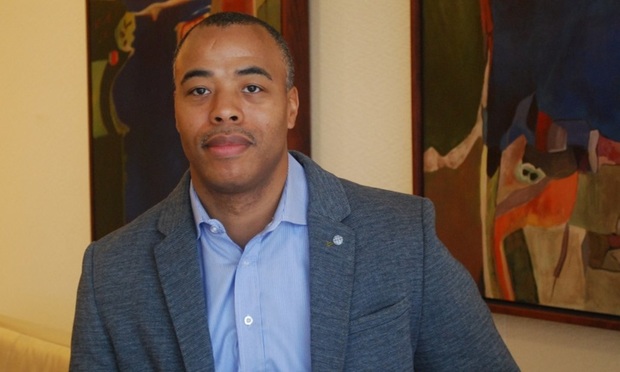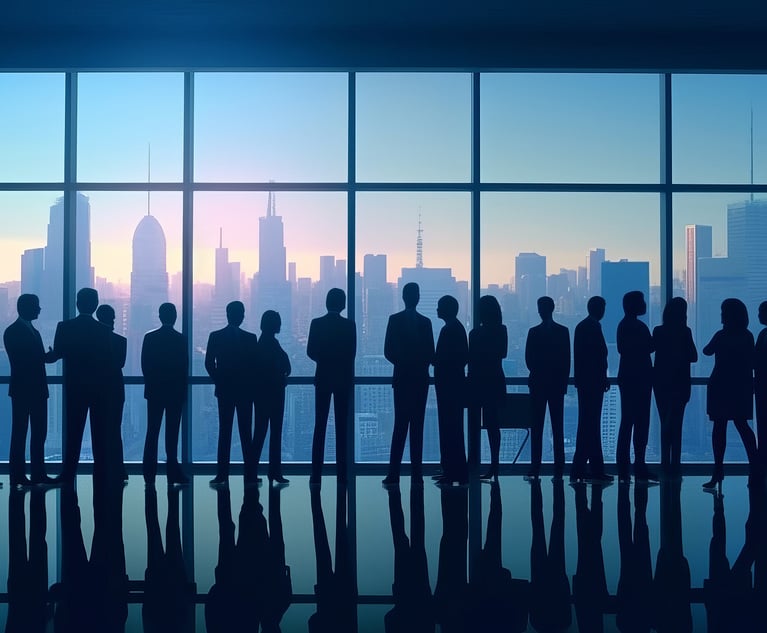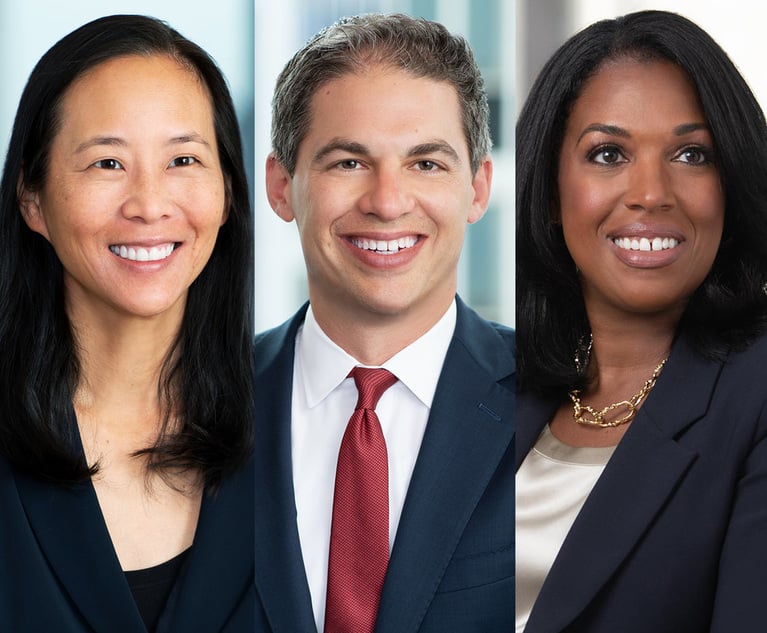Goodwin Procter Names New Head of Diversity and Inclusion
Bernard Guinyard, a former head of diversity and inclusion at Ropes & Gray now headed to Goodwin Procter, caught up with The American Lawyer to discuss how the Mansfield Rule and #MeToo movement will change Big Law.
January 11, 2018 at 07:00 AM
5 minute read

Bernard Guinyard spent five years leading Ropes & Gray's diversity and inclusion initiatives. From 2010 to 2015, he was instrumental in helping the Boston-based Am Law 100 firm increase diversity among its ranks through targeted recruiting efforts and other initiatives.
Now, after a few years consulting with various corporations, Guinyard is returning to Big Law as the new director of diversity and inclusion at Goodwin Procter, another Am Law 100 firm with Boston roots that re-branded itself in 2016. Guinyard is replacing Laura Acosta, who is stepping into a new role as managing director of professional development and training at Goodwin Procter. The American Lawyer spoke with Guinyard, who will be based in New York, to discuss his plans for his new position, as well as his take on the ever-expanding, ever-perplexing issue of diversity at law firms.
TAL: So what made you decide to go back to law firms and why did you choose Goodwin Procter—was it the Boston connection?
BG: [Laughing.] Doing the consulting work, I was trying to figure out what are the next steps of what I wanted to do and what I missed. And I did miss practicing the art of [diversity and inclusion] at the end of the day. I knew [Acosta] when she first stepped into the role and I was very impressed with the things she's accomplished in such a short period of time. She's invested a lot around bias and the Mansfield Rule. But after I met [Goodwin Procter's chairman David Hashmall], and learning that he made diversity and inclusion his platform, it was really inspirational.
Diversity and inclusion sometimes is, 'We want it, we like it, we want to invest in it,' but is it the leader really stepping up and saying, I'm going to own this? In listening to [Hashmall] and why he decided to make this his platform, I thought that I would like to join an organization where the leader, the chair of the firm, is really going to own this, really try to push it and be someone who's passionate about seeing change.
TAL: What are your goals in your new position at the firm?
BG: I really want to spend time understanding the culture. Every firm and organization has a different culture. I want to understand the experiences of the associates and the professional staff to ensure that whatever strategy I roll out is the appropriate strategy. Some of the things that we're really looking at is how do we push the initiatives deeper into the organization so it's owned by our business units and the partners. People are looking for the tools and resources so that they can own it and that's inspiring. I want to make sure that what we identify as the opportunities to drive change are the right thing for our folks to be focusing on.
TAL: Issues surrounding diversity in the legal industry are obviously multifaceted, from pipeline problems to partnership promotions. What do you see as perhaps the biggest issue facing law firms with respect to diversity in 2018?
BG: I still think that it's the internal conversation. It's how we're shifting the culture and the mindset around the discussion of diversity and inclusion. We're all attracted to focusing on the representation piece. [But] when you're looking at just that representation piece and not understanding the systems and processes that are in play that are impacting our ability to retain and advance attorneys of color, women, sexual orientation, [etc.], we're continuing to stay in this cycle of trying to fix the problem without really taking a step back and saying we have to address what's happening in our organization [and] who's owning it.
So we have to really hold ourselves accountable and really pushing ourselves to step outside our comfort zones to drive a cultural change and drive a mindset.
TAL: While it's not a classic diversity issue, the #MeToo movement has placed a microscope on issues relating to gender equality, such as pay disparity and the lack of women in leadership roles, with women of color often having an even more marginalized voice in the conversation. In your new role, how do you plan on addressing these issues?
BG: The beauty of the #MeToo movement is they're giving myself, my peers across the industry and diversity professionals at large, tools and reasons for us to have the conversations. They're pushing us to push our organizations to take action. We're at this place in our journey around diversity and inclusion [that] we have to do something and we all need to take the opportunity to be a voice to execute [change] and be public about it.
It is a gift and I will say that over the last two-to-three years, the media and what's going on across this nation has really allowed diversity to take center stage and [push] the ownership of organizations to kind of move the needle forward. The good thing is that companies, CEOs and chairs have started to speak out. We need to ensure that we keep it going.
All interviews are condensed and edited for style, grammar and clarity.
This content has been archived. It is available through our partners, LexisNexis® and Bloomberg Law.
To view this content, please continue to their sites.
Not a Lexis Subscriber?
Subscribe Now
Not a Bloomberg Law Subscriber?
Subscribe Now
NOT FOR REPRINT
© 2025 ALM Global, LLC, All Rights Reserved. Request academic re-use from www.copyright.com. All other uses, submit a request to [email protected]. For more information visit Asset & Logo Licensing.
You Might Like
View All


Law Firms Close Southern California Offices Amid Devastating Wildfires

Trending Stories
Who Got The Work
Michael G. Bongiorno, Andrew Scott Dulberg and Elizabeth E. Driscoll from Wilmer Cutler Pickering Hale and Dorr have stepped in to represent Symbotic Inc., an A.I.-enabled technology platform that focuses on increasing supply chain efficiency, and other defendants in a pending shareholder derivative lawsuit. The case, filed Oct. 2 in Massachusetts District Court by the Brown Law Firm on behalf of Stephen Austen, accuses certain officers and directors of misleading investors in regard to Symbotic's potential for margin growth by failing to disclose that the company was not equipped to timely deploy its systems or manage expenses through project delays. The case, assigned to U.S. District Judge Nathaniel M. Gorton, is 1:24-cv-12522, Austen v. Cohen et al.
Who Got The Work
Edmund Polubinski and Marie Killmond of Davis Polk & Wardwell have entered appearances for data platform software development company MongoDB and other defendants in a pending shareholder derivative lawsuit. The action, filed Oct. 7 in New York Southern District Court by the Brown Law Firm, accuses the company's directors and/or officers of falsely expressing confidence in the company’s restructuring of its sales incentive plan and downplaying the severity of decreases in its upfront commitments. The case is 1:24-cv-07594, Roy v. Ittycheria et al.
Who Got The Work
Amy O. Bruchs and Kurt F. Ellison of Michael Best & Friedrich have entered appearances for Epic Systems Corp. in a pending employment discrimination lawsuit. The suit was filed Sept. 7 in Wisconsin Western District Court by Levine Eisberner LLC and Siri & Glimstad on behalf of a project manager who claims that he was wrongfully terminated after applying for a religious exemption to the defendant's COVID-19 vaccine mandate. The case, assigned to U.S. Magistrate Judge Anita Marie Boor, is 3:24-cv-00630, Secker, Nathan v. Epic Systems Corporation.
Who Got The Work
David X. Sullivan, Thomas J. Finn and Gregory A. Hall from McCarter & English have entered appearances for Sunrun Installation Services in a pending civil rights lawsuit. The complaint was filed Sept. 4 in Connecticut District Court by attorney Robert M. Berke on behalf of former employee George Edward Steins, who was arrested and charged with employing an unregistered home improvement salesperson. The complaint alleges that had Sunrun informed the Connecticut Department of Consumer Protection that the plaintiff's employment had ended in 2017 and that he no longer held Sunrun's home improvement contractor license, he would not have been hit with charges, which were dismissed in May 2024. The case, assigned to U.S. District Judge Jeffrey A. Meyer, is 3:24-cv-01423, Steins v. Sunrun, Inc. et al.
Who Got The Work
Greenberg Traurig shareholder Joshua L. Raskin has entered an appearance for boohoo.com UK Ltd. in a pending patent infringement lawsuit. The suit, filed Sept. 3 in Texas Eastern District Court by Rozier Hardt McDonough on behalf of Alto Dynamics, asserts five patents related to an online shopping platform. The case, assigned to U.S. District Judge Rodney Gilstrap, is 2:24-cv-00719, Alto Dynamics, LLC v. boohoo.com UK Limited.
Featured Firms
Law Offices of Gary Martin Hays & Associates, P.C.
(470) 294-1674
Law Offices of Mark E. Salomone
(857) 444-6468
Smith & Hassler
(713) 739-1250










